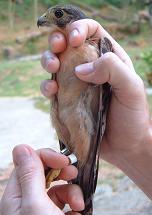Scientists asking public to help find kestrel feathers |09 May 2005

The researchers, from the University of Kent, are working with Nature Seychelles on the project. The team, led by Dr Jim Groombridge, has been catching kestrels to take blood samples to test the genetic diversity of the birds.
DNA samples can also be taken from feathers and other tissue. Dr Groombridge has worked for six years on the recovery of the Mauritius kestrel.
"The Mauritius kestrel was saved from the brink of extinction by conservation action,” he said. "There was just a single known breeding pair in 1974, and we nearly lost it as a species. Happily there are now about 800-1,000 birds today."
"Studies of the DNA of the Mauritius kestrel show it to have very little genetic diversity, as the population descended from just that single pair," said Dr Groombridge.
"When we compare the Seychelles kestrel DNA we find that there is a similar severe lack of genetic diversity within the population, but this does not seem to have been a problem for the species." The Seychelles kestrel is believed to have a population of around 400 pairs, mainly on Mahe, but also some on Praslin and Silhouette.
"The recovery of the Seychelles katiti offers hope to all sorts of other endangered bird species in Seychelles," said Rachel Bristol, science coordinator for Nature Seychelles. "But more DNA samples from katitis are needed to confirm the genetic 'health' of the katiti population across Mahe, Praslin and Silhouette."
Nature Seychelles is asking people who might be able to provide kestrel feathers for the study to come forward. "(Feathers) are often found below nest or roost sites, and it is not uncommon for katitis to roost in the roves of houses," she said.
"The katiti usually breeds in September and October but we need the feathers as soon as possible, and information about exactly where they were found."
The katiti is the smallest kestrel in the world and Seychelles’ only native bird of prey, Ms Bristol said. "There is no other bird here quite like it." However, superstitions from the past have associated the katiti with bad luck. That may have been a problem for the birds in some places, she noted.
Nature Seychelles can provide advice and nest boxes to encourage the birds to nest in places that are safe from rats, cats and other introduced predators, Ms Bristol added.




